Azaadi Through the Aperture: Immortalising a Nation’s Awakening
- Aftar Ahmed

- May 23, 2021
- 7 min read

Henri Cartier Bresson (L), Homai Vyarawalla, Kulwant Roy (R)
Image Credits: streethunters.net/eflux/Firstpost
History dissolves: ashes to ashes, dust to dust. What salves our regret over taking birth without the confines of a particular period of time are tangible artefacts. Fortunately for old souls who feel outcast in modernity, time travel exists as polaroids: frozen friezes of public memory.
In the final moments of India’s strife for emancipation, the blood-lined streets and drawn faces of a people shedding shackles of centuries, were all recorded for posterity by three stalwarts of the lens. They painted the many moods of a nation on the move through space, separation, and history. Their unparalleled role in driving India towards its destiny comes alive in snaps of black and white.
That a day would come, when their life’s work would evoke deeper veins of passion in a country steadily moving away from its history, was little realized by them. But here we are: tracing the birth of our nation through the finer sensibilities of Roy, Cartier, and Vyarawalla. Let us recount the poignant moments in which India was conceived and revisit the turbulent life and times of these passionate photographers.
Kulwant Roy: Onwards To Freedom!

Image Credits: IPAF
As the demand for freedom reached a crescendo in the years leading up to 1947, one man wandered station after station, awaiting the Mahatma's arrival; a young photojournalist from the would-be Nation, playing his part in shaping the vision and ethos in which the new-born country would be rooted. This was Kulwant Roy, and often do we find ourselves accompanying him from the side-lines, for his photos are a regular feature in our History textbooks.

'Gandhi And Jinnah Arguing’, Roy, 24/11/39, Image Credits: IPAF
Roy’s camera-clad figure, and singleness of purpose, soon acquired limelight within the Nationalist circles- “Oh! There’s the man! He who has determined to immortalize these years of light, sound, and fury. Here is the man who will remind the coming generations of our exploits, for years henceforth-” was a reverberating sentiment. However, for all his insight, and a knack for historicity, much of Roy’s work lounged in obscurity until very recently. India Photo Archive Foundation has worked with photographer Aditya Arya to recover the negatives that Roy left behind.

Pt. Nehru, Mahatma Gandhi, and Sardar Patel, Roy 1946/Image Credits: IPAF
The memories thus salvaged, as well as the better known snapshots, are a treasure trove for history aficionados. From Nehru’s placid resolve at conferences, to the Mahatma’s stature and command descending trains before him, Roy’s artistry leaps out of the lens and across the bounds of time. This wistful poetry of pre-independence years wrought by him is a marvellous legacy of where We, as a nation, are coming from.

R-L- Lord Mountbatten, Nehru, Sardar, and Acharya Kriplani, Roy 1947/Image Credits: IPAF
Roy began his career as an employee of the Royal Indian Air Force, snapping lush views of his Lahore hometown for the Company, before his lifelong romance with photos drew him to the North of modern day India. There he set up ‘Associate Press Photographs’, the company that singlehandedly produced much of what survives as our collective memory of the Delhi of 1940’s: Congressmen flocking the streets as future beckoned, the Mahatma greeted by throngs at Nizamuddin Railway Station, of elations, elegies and heartburns that coloured our Movement for Independence.

Meerut Congress session, Roy 1946/Image Credits: IPAF
The focal point of Roy’s vision was the radiance of intellect and devotion to Motherland exuded by the Mahatma.Year after year he would be drawn to the station at Nizamuddin to watch the Mahatma alight, as a place of worship draws the pious. These photographs reflect the artist’s reverence for the towering persona of the Mahatma.
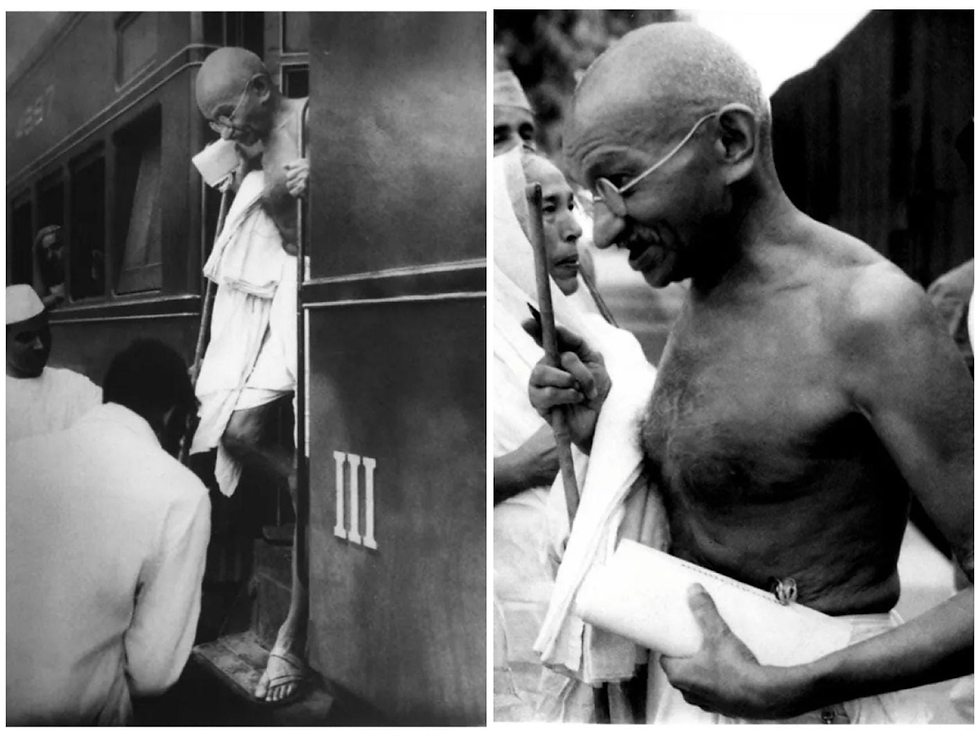
Mahatma Gandhi, Roy 1940/Image Credits: IPAF
Nevertheless, he didn’t shy away from recording other leaders on their daily quest for freedom. Moments suspended in time, conversations muted within the folds of Roy’s camera, and leaders enroute to history, or even the famous ‘signing of the Constitution of India’, are mere shades in the spectrum of Roy’s body of work. The immensity of an artist is comprehended naught but in the larger passing of time, perhaps why We, after almost 80 years, have finally begun to express awe at Kulwant Roy’s expertise.
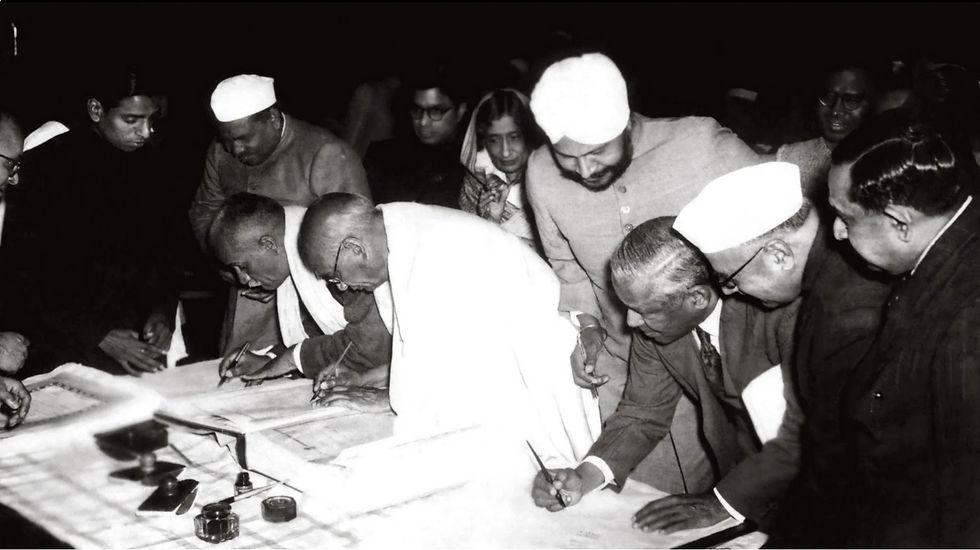
Sardar Patel signs the Constitution of India, Roy/Image Credits: Firstpost
Henri Cartier Bresson: Interludes Of Bloodshed

Henri Cartier Bresson/Image Credits: Livemint
Frenchman Henri Cartier Bresson propounded the street photography genre, an art he perfected during the Indian partition of 1947. His candid stills captured the raw, unsuspecting moods of his subjects. Shortly after reaching India in September of 1947, he began recording the jubilant, yet sepulchral nature of that fateful year. Most of his work has no one subject, shedding light, instead, on the mass character of India’s struggle for independence with its coverage of crowds.
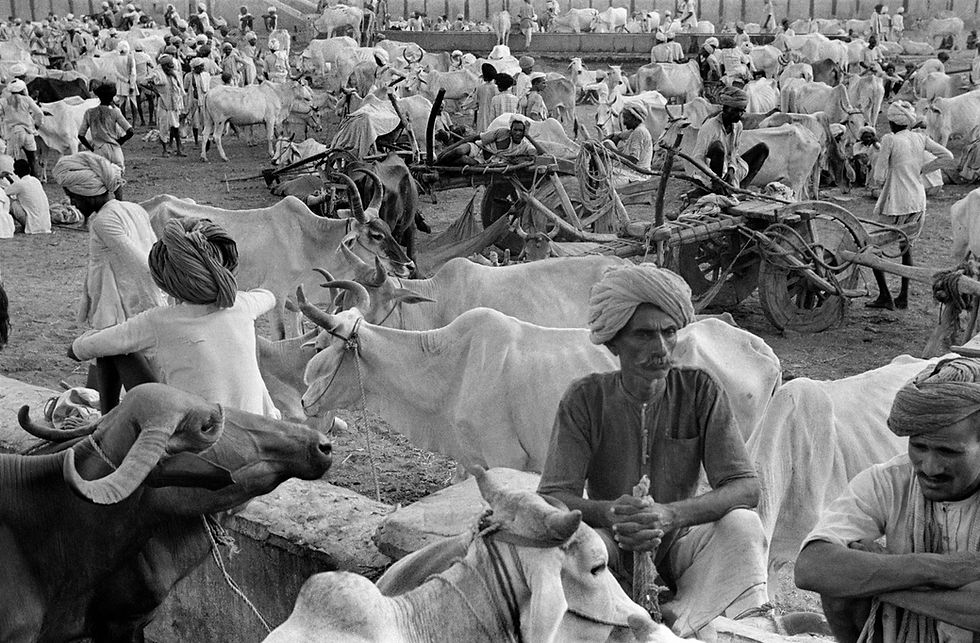
Peasants coming into the city gather with their cattle by an outside wall, Jaipur, India 1947
Bresson/Image Credits: The New York Review
After founding the Magnum Photos Studio in 1947, Bresson set off to record the socio-political turmoil in a newly de-colonized Asia.
The dream of independence, once realized, revealed itself a miscarriage of expectations conceived: in the blink of an eye the red of partition unfurled, a horrific rose blooming against a new dawn. As rivers ran crimson with the blood of communal violence, Bresson captured the deathly silence hovering over the countryside betwixt the uproars of insanity. These pictures that bespoke of unsettled normalcy, calcified Bresson within the tomes of Indian history.

Muslim refugees on a train from Delhi to Lahore, in Kuinkshaha, India, Bresson1947
Image Credits: The New York Reiview
Other pictures by Bresson deal exclusively with the Mahatma as the subject. There are snaps where Gandhi isn’t even visible in the frame, but the reverence on the faces of people evokes his essence. Most of these works date to the days following the Mahatma's demise. On 30th of January, 1948, Bresson recorded Gandhi’s final hours. What lay ahead was the farthest from anyone’s imagination. These became some of Bresson’s most powerful works; on display are his finesse in bringing alive the subject even in its absence.

Gandhi leaving Meherauli, Delhi, India, Bresson 1948/Image Credits: Aperture
Hours later, the Mahatma was assassinated. In documenting the aftermath of the mishap, Bresson beautifully captured the mood of a nation in mourning. His 14 photos of the funeral, particularly 'Train Carrying Gandhi's Ashes', bared the essence of the country's loss and brought him worldwide acclaim. These photos are some gems from the Nationalist Movement that are on display at the Rubin Museum in New York.

Train Carrying Gandhi’s Ashes, Bresson/Image Credits: Livemint
Bresson’s ideas influenced a new crop of Indian photo-journalists like Raghu Rai and Raghubir Singh. Interestingly, Bresson's vision even impacted the famous filmmaker Satyajit Ray's widely acclaimed 'Apu Trilogy' of films! While critics argue that Bresson was ‘putting the East to use as a career’, the candour of his art is undeniable: he put his heart and soul into capturing one of the most moving periods in India’s recent memory. In capturing the rawness of 1947-48, he shaped an everlasting vision of modern Indian history.

Gandhi’s secretary watches the flames on his funeral pyre, Bresson/Image Credits: Livemint
Homai Vyarawalla: Out Of The Long Night

Homai Vyarawalla/Image Credits: TheQuint
The nation resuscitated, was shot in its fledgling moments by the genius of none other than Homai Vyarawalla. Operating in an epoch suspended so precariously in time that Indian women could finally dream of becoming prime ministers, while being largely confined by chains of domesticity, Homai flouted all conventions to perfect her art. The distinction of being a Padma Vibushan awardee, and India’s first female photojournalist, were perhaps trivial compensations for the odds that she fought.

Pt. Nehru Releases A Dove: Nation Reborn, Vyarawalla/Image Credits: TheQuint
Homai’s lens was focused on the events and figureheads who would define the nation we became post-1947. The funerary elements of an era gone by- the final rites of Gandhi, or penultimate salute of the last Viceroy- were the ashes in which the phoenix of Vyarawalla’s art was born. Where Bresson’s frame of Indian-ness ended, there Vyarawalla’s investigation into the minutiae of nation building began.

Gandhi’s Last Rites, Vyarawalla/Image Credits: TheQuint

Lord Mountbatten’s Final Salute, Vyarawalla/Image Credits: TheQuint
It was at the age of 13 that Vyarawalla ran into her future husband. It is a story well remembered in the world of Indian photography: the young couple strolling the streets of Bombay, recording the nitty-gritties of a City coming to life under the gaze of their lens. Photojournalism was fast becoming a viable career option and Vyarawalla promptly took to it, graduating from the prestigious JJ School Of Art a decade later. The constraints of the time induced Homai to release her initial work under her husband’s name, for even the idea of a woman photographer was mocked in news circles of the day.

Girls At JJ School Of Art, Bombay, Vyarawalla/Image Credits: TheQuint
Soon enough, though, the genius shone through, and to say that artistic minds of the country were impressed with her, will be an understatement. Homai’s records drew awe: the nation under construction was her canvas and every moment pivotal to describing ‘India of the 20thCentury’, passed through her scrutiny. From the first Republic Day, to the arrival of the Dalai Lama, she captured it all.
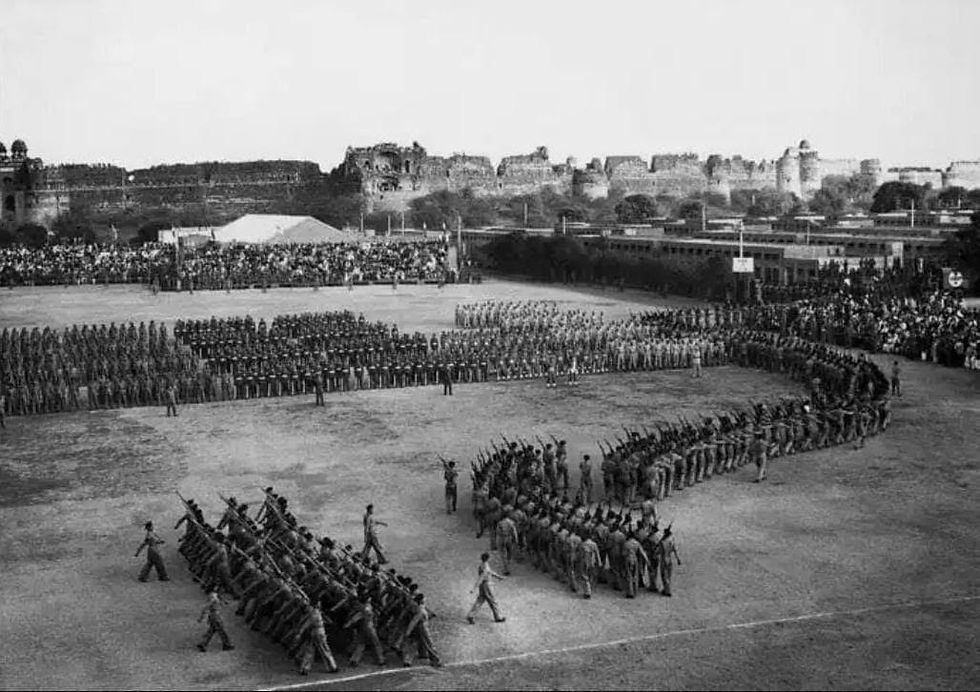
India’s First Republic Day Parade, Vyarawalla/Image Credits: Quint
Homai was self-confessedly extremely fond of clicking candid shots of Pt. Nehru whom she described as an extremely photogenic person. The charisma of the first prime minister is quite evident in her snaps from the 50’s. While she did enjoy recording famous personalities of the 60’s and 70’s period too, she chose to retire in the aftermath of her husband’s demise. Hers is a coveted contribution, not only to the sphere of photography, but also to the demand for emancipation of Indian women- the true freedom.
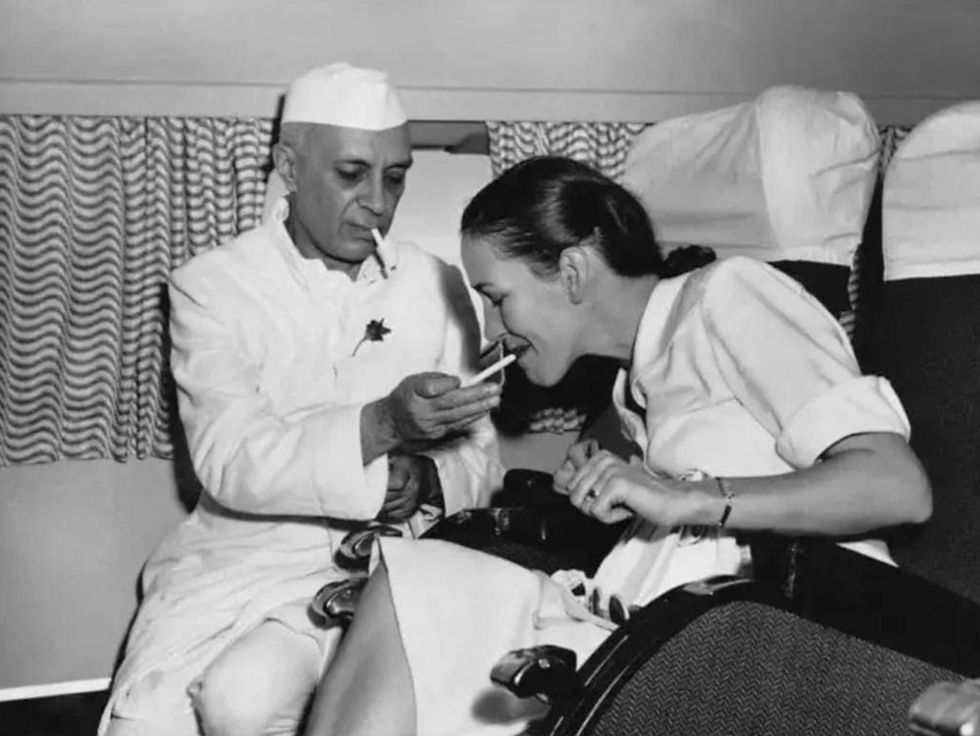
Pt. Nehru And The Wife Of A British Diplomat, Vyarawalla/Image Credits: TheQuint
By Samya Verma
Samya Verma is a third year student of (not) history at Hindu College. She swears by caustic sarcasm, political satire, and dark humour. With no plans for the future, she is currently soliciting advice on how to avoid unemployment; feel free to chip in at symposium.samya@gmail.com






Comments